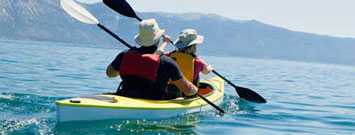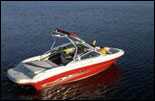Stay Safe While Boating
 Wearing a life jacket can dramatically decrease your chances of drowning while boating. "Wear It!" every time you're on the water.
Wearing a life jacket can dramatically decrease your chances of drowning while boating. "Wear It!" every time you're on the water.
Protect the Ones You Love
In an effort to raise parents' awareness about the leading causes of child injury in the United States and how they can be prevented, CDC has launched the "Protect the Ones You Love" initiative. Parents can play a life-saving role in protecting children from injuries. Learn more.
Everyone, on all types of boats, should wear properly-fitted life jackets, or personal flotation devices (PFD). By wearing a life jacket, you can dramatically decrease your chances of drowning while boating.
Know the Facts
Recreational boating can be a wonderful way to spend time with family and friends. And making safety a priority can ensure that boating stays fun.
Consider that:
- In 2009, 3,358 people were injured and 736 died in boating incidents. Of those who drowned, 9 out of 10 were not wearing life jackets.
- Of the people who died in a boating incident in 2009, more than 7 out of 10 (73%) drowned. More than 90 percent of the people who drowned were not wearing a life jacket.
- Alcohol use was the leading contributing factor in fatal boating incidents.
Reduce Your Risk
Whenever you are headed out on the water, keep these tips from the U.S. Coast Guard in mind:
Wear it. Properly fitted life jackets can prevent drownings and should be worn at all times by everyone on any boat. Comfortable Coast Guard-approved life jackets are now widely available.
Don't Drink. Alcohol use affects judgment, vision, balance, and coordination, and is involved in about a third of all recreational boating fatalities. Boating under the influence of alcohol is just as deadly as drinking and driving. Not only is it dangerous to operate a boat while under the influence of drugs or alcohol, it's also illegal in every state in the United States.
It's not just boat operators at risk from drinking while boating. Passengers are at greater risk of injury as well. In fact, 46% of all boating fatalities occurred when vessels were docked, anchored, or drifting. Due to sun exposure and heat, both operators and passengers are likely to become impaired more quickly, drink for drink, when on the water. So play it safe and avoid alcohol when you're on a boat.
Take a Course. More than 7 out of every 10 boating incidents are caused by operator error. Boating education courses teach the rules for safe operation and navigation of recreational boats, and can help boat operators keep their passengers safe.
Get a Vessel Safety Check. The Vessel Safety Check (VSC) is a free public service provided by the U.S. Coast Guard Auxiliary and U.S. Power Squadron volunteer organizations. For more information on the VSC Program, visit their web site: www.vesselsafetycheck.org .
 Know about carbon monoxide (CO). Carbon monoxide (CO) is an odorless, colorless, poisonous gas that is emitted by all internal combustion engines, such as boat engines and onboard motor generators. In the early stages, the symptoms of CO poisoning are similar to seasickness, but CO can kill in a matter of minutes, whether you are inside or outside of your boat. To avoid CO poisoning, be aware of the risk, ensure sufficient ventilation, properly install and maintain equipment, and use CO detectors, especially in living and sleeping areas.
Know about carbon monoxide (CO). Carbon monoxide (CO) is an odorless, colorless, poisonous gas that is emitted by all internal combustion engines, such as boat engines and onboard motor generators. In the early stages, the symptoms of CO poisoning are similar to seasickness, but CO can kill in a matter of minutes, whether you are inside or outside of your boat. To avoid CO poisoning, be aware of the risk, ensure sufficient ventilation, properly install and maintain equipment, and use CO detectors, especially in living and sleeping areas.
See "Prevent Carbon Monoxide Poisoning on Your Boat."
Also, be sure to check state and local requirements, available at the National Association of State Boating Law Administrators Web site .
More Information
The following resources offer information that can help you stay safe on the water:
CDC Resources
-
 Facts and Resources about Water-related Injuries
Facts and Resources about Water-related Injuries - Protect the Ones You Love: Drownings Fact Sheet
- Healthy Swimming and Recreational Water Facts
Download or listen to a podcast
- Protect the Ones You Love from Drowning [PODCAST – 3:05 minutes] (2008)
- Staying Safe in the Water [PODCAST – 5:38 minutes] (2008)
- Staying Safe on the Water [PODCAST – 3:45 minutes] (2008)
External Resources
- Page last reviewed: June 20, 2012
- Page last updated: June 20, 2012
- Content source:
- National Center for Injury Prevention and Control
- Page maintained by: Office of the Associate Director for Communication, Digital Media Branch, Division of Public Affairs




 ShareCompartir
ShareCompartir
